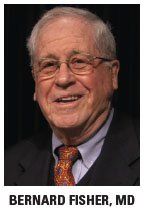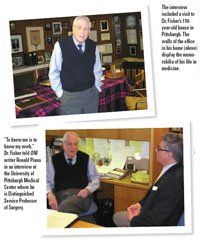The surgeon who challenged the breast ca paradigm
Bernard Fisher, MD received his medical degree in 1943 from the University of Pittsburgh School of Medicine. As a young doctor, he was torn between a life in the operating room and one in the research lab. His curiosity about the biology of the diseases that were being treated by surgery eventually led to his decision to combine those interests.
ABSTRACT: Research led to groundbreaking breast cancer clinical trials
Bernard Fisher, MD received his medical degree in 1943 from the University of Pittsburgh Schoo

l of Medicine. As a young doctor, he was torn between a life in the operating room and one in the research lab. His curiosity about the biology of the diseases that were being treated by surgery eventually led to his decision to combine those interests.
Dr. Fisher graciously made time in his schedule to talk with ONI about his life in science. The interview started in his office at the University of Pittsburgh Medical Center, where he is Distinguished Service Professor of Surgery. From the start he made it clear: “To know me is to know my work.” But ONI also wanted to know the early influences and career choices that ultimately led to his pioneering breast cancer studies.
At about the time that Dr. Fisher began his medical studies, his great-uncle, a physiologist and surgeon who had previously taught at Vanderbilt and Western Reserve Universities, moved to the University of Pittsburgh to create a lab to develop an adrenal cortical extract for treatment of Addison’s disease.
“I got my first taste of lab work there, while I was a medical student. They would get big containers of adrenal glands from the slaughterhouse, and one of my jobs was to remove the medullas from those glands,” Dr. Fisher said.
At the same time, he said, “I discovered that either radical or super-radical surgery was the only cure for many disorders and that the operating room was where the real drama of medicine took place. Consequently, I decided to become a surgeon.”
During his surgical residency, he said, “I began to realize that the basis for many of the operations that I was performing was questionable. I realized the need for a greater understanding of the biology of the diseases that I was treating.”
Thus, Dr. Fisher was determined to participate in what was, at that time, one of the few surgical research programs in the country-the one at the University of Pennsylvania’s Harrison Department of Surgical Research. He convinced Dr. I. S. Ravdin, then chairman of the Department of Surgery at Penn, and a former brigadier general who had operated on President Eisenhower, to offer him a research position.
“I was a board-certified surgeon,” Dr. Fisher said, “but I still fed the rats on weekends. I developed a surgical technique to cannulate bile ducts in animals, keeping them alive for weeks, as part of my effort to learn more about liver regeneration.”
When his tenure at Penn ended, Dr. Fisher returned to the University of Pittsburgh School of Medicine, where he created the Laboratory of Sur-gical Research. “I had only a small stipend to live on, but I was happy. It was my lab, and I was given the opportunity to do as I pleased,” he commented.
Dr. Fisher said that his early years in the lab, beginning in 1952, comprised three distinct areas of investigation: his “Promethean Period” (liver regeneration), his “Blue Period” (hypothermia), and his “Chimeric Period” (transplantation biology). At that time, he said, he had no interest in breast cancer research.
The National Surgical Adjuvant Breast Project
In 1957 Dr. Ravdin, who chaired an NIH panel on cancer chemotherapy, invited Dr. Fisher and

several other surgeons to Stone House on the NIH campus to discuss the creation of a new clinical trials program, the Surgical Adjuvant Chemotherapy Breast Project, which was to be headquartered at Roswell Park Cancer Institute in Buffalo, New York.
Dr. Fisher said, “At that time it was thought that surgeons were responsible for the failure to cure more patients because they disseminated tumor cells during cancer surgery.”
It was believed that the use of perioperative chemotherapy, ie, during surgery and for 2 days afterward, would destroy such cells. In order to test that concept, the Breast Project group initiated its first trial, a randomized study of radical mastectomy with or without thiotepa, and enrolled its first patient in 1958.
“Those early study findings piqued my interest in how tumors metastasized and stimulated my interest in clinical trials, a process that was just being introduced as a mechanism for hypothesis-testing,” Dr. Fisher said. “The thiotepa study demonstrated, for the first time, that the natural history of some patients with breast cancer could be altered.”
In 1967, after serving as head of the executive committee of the Surgical Adjuvant Chemotherapy Breast Project (the group subsequently became known as the NSABP), Dr. Fisher was appointed chairman. At that time, interest in the group was lagging, and a new cohesiveness was needed. So, in 1970, he centralized the operations and biostatistical centers by moving them from Roswell Park to the University of Pittsburgh.
The alternative hypothesis
Dr. Fisher described his years in the laboratory during the 1960s and ’70s as a period of “pure intellectual freedom.” His experimental work with tumor metastasis was highly productive.
“My research findings led me to question the Halstedian principle of radical surgery, which had dominated breast cancer treatment for more than 75 years. At that time, my colleagues thought that my thesis was heretical.”

Halsted contended that the greater the extent of surgery, the greater the potential for cure. “Halstedian concepts held that cancers metastasized sequentially, from the primary site through the lymphatic vessels to the lymph nodes and then to distant sites,” Dr. Fisher said. “Halsted did not consider tumor-cell circulation in the blood to be a factor in tumor spread.”
On the basis of his lab work, Dr. Fisher hypothesized that breast cancer was likely to be a systemic disease by the time a patient was seen by her doctor, and that tumor cells spread unpredictably to distant sites via the lymphatic and vascular systems. Dr. Fisher realized that his hypothesis would be supported by the surgical community only if data were obtained from randomized clinical trials conducted to test that thesis.
The Fisher hypothesis was tested in an NSABP trial begun in 1971. Support for that thesis was obtained in 1977. Those findings provided Dr. Fisher with the justification for another trial, which, in 1985, showed that lumpectomy plus radiation therapy was as effective as total mastectomy. The 25-year update of that study, published in 2002, confirmed those results.
For the first time, there was evidence to justify the use of a paradigm that was based on scientific investigation and that permitted less radical surgery for the treatment of cancer.
Dr. Fisher pointed to a picture of a breast cancer patient: “Twenty years ago, she had a radical mastectomy on her right breast. Her cancer recently recurred in her left breast, and she had a lumpectomy. The difference between the results of the two types of operation in the same patient shows the progress that has been made as a consequence of scientific investigation.”
Dr. Fisher said his new hypothesis “clearly indicated to me that the benefits from the surgical treatment of breast cancer would arise only with the use of other therapies in conjunction with surgery.”
To test that premise, in the 1980s and ’90s, the NSABP, under Dr. Fisher’s leadership, conducted 23 additional breast cancer trials in nearly 43,500 women. These trials, which were also based largely on concepts formulated from laboratory research, involved the use of adjuvant radiation therapy, adjuvant hormonal therapy, preoperative chemotherapy, and chemoprevention with tamoxifen.
After 2 hours of discussion, Dr. Fisher decided that the interview should continue over lunch at his house, which was 5 minutes away. During lunch, he talked enthusiastically about one of his heroes, Thomas Kuhn, the philosopher and historian of science who introduced the concept that paradigm change is the result of testing of well-conceived hypotheses that arise from scientific investigation.
“My familiarity with Kuhn’s philosophy has led me to believe that perhaps the most important accomplishment of the 20th century relates to the change in the process of therapeutic decision-making that results from the conduct of well-designed clinical trials,” he said.
After lunch, Dr. Fisher gave a tour of his 110-year-old house, including a room filled with photos of exotic places. One picture showed Dr. Fisher atop the Great Wall, shoulder to shoulder with a Chinese thoracic surgeon. It was taken in 1977, when Dr. Fisher was part of a delegation of 10 academic physicians sent by the National Academy of Sciences to determine the state of cancer research and treatment in China.
On another wall was a watercolor of a turtle, an exaggerated neck protruding from its shell. The legend below it reads, “Observe the turtle: He progresses only when his neck is out.” With a sardonic smile Dr. Fisher said, “You know what happens when you stick your neck out.”
On the drive back to his office, Dr. Fisher again emphasized the importance of translating bench work to the clinic.
“What I did in my clinical trials was an extension of what I did in the laboratory,” Dr. Fisher commented. “A clinical trial is just a mechanism by which to evaluate what you’ve done in the laboratory. It’s not a career; the trial results need to translate to the clinic.”
Only through scientific research will progress continue to be made in the understanding and treatment of cancer, he said, adding that his goal has always been to “eliminate empiricism from therapeutic decision-making.”
How Supportive Care Methods Can Improve Oncology Outcomes
Experts discussed supportive care and why it should be integrated into standard oncology care.